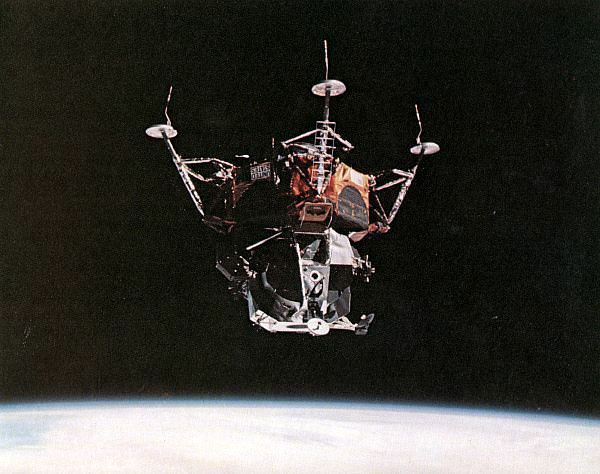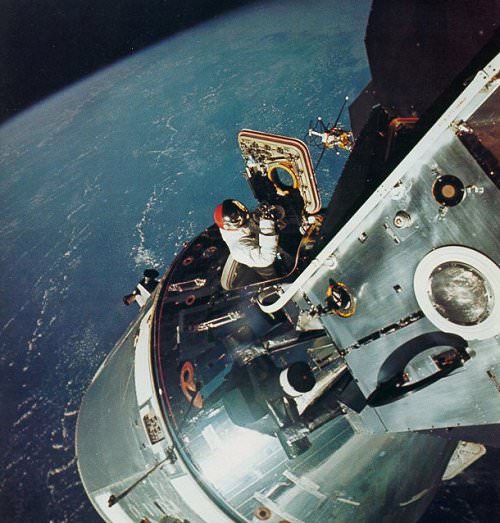50 Years Ago Today, Apollo 9 Launched and Paved the Way for a Lunar Landing
The flight gave astronaut Rusty Schweickart a chance to look back at Earth.
Fifty years ago, 10 days in space pushed human spaceflight forward with spectacular, groundbreaking testing. On March 3, 1969, a Saturn V rocket launched three brave astronauts into low Earth orbit as part of Apollo 9, a mission on which the crew tested the spacecraft that would later land humans on the lunar surface.
The second mission to be launched into orbit by a Saturn V rocket, Apollo 9 was the third crewed mission in the U.S. Apollo program. Apollo 9 saw the first flight of the command and service module (CSM) with the Apollo lunar module (LM). Aboard Apollo 9 was Cmdr. James McDivitt, command module pilot Dave Scott and LM pilot Rusty Schweickart.
As the NASA-produced Apollo 9 documentary "Three to Make Ready" from 1969 highlights, the Apollo 9 mission was not only critical to a future moon landing; it also tested technologies and capabilities that, at the time, were cutting-edge. As Schweickart told Space.com, while the testing done in space during that mission may seem "incidental" compared to the work astronauts have now done aboard the International Space Station, it was monumental at the time.
Related: On Apollo 9, a Jammed Camera Changed Spacewalking Astronaut's Life (Video)
Of all the groundbreaking testing completed during the mission, perhaps the most obviously critical for the lunar landing was the LM testing Schweickart did. Although it was the spacecraft's first test in outer space, Schweickart wasn't the least bit nervous, he told Space.com.
The training and experiences he'd had as a fighter pilot were far more nerve-wracking, he said. "Not always, but certainly in my case and in the case of most of the people back then, you've been flying high-performance fighter jets around in situations which are, in some sense, more dangerous," he said. Schweickart also commended the extensive training he received at NASA, saying that because of this preparation, "I certainly never felt the least bit of fear or anxiety about coming out of it alive."
But Schweickart did have a very unexpected experience on a spacewalk. On the fourth day of Apollo 9, he and Scott embarked on an extravehicular activity (EVA). Scott was filming the maneuver — the first Apollo spacewalk — when the camera jammed.
Breaking space news, the latest updates on rocket launches, skywatching events and more!
Cmdr. McDivitt gave Scott 5 minutes fix the camera, and so, for 5 incredible minutes, Schweickart had the opportunity to take in his surroundings. "Having that 5 minutes made a tremendous difference because it gave me a moment to literally transition from being an astronaut in the middle of a very busy spaceflight to 5 minutes of just being a human being realizing where he was."
For Schweickart, those moments reflect the true importance of Apollo 9 and the Apollo program in general. "It seems to me the real significance of Apollo was that view of the Earth and recognizing that, you know, all of life is here on Earth," he said.
"Looking at it from the perspective of the moon, you become very, very aware of the uniqueness of life and that very, very thin boundary called the atmosphere that separates all the life we know from infinite universe," he said. "To me, the significance of Apollo is, in essence, we went to the moon and found the Earth."
The world at large first experienced this incredible perspective with the "Earthrise" photo, taken by astronaut Bill Anders during the Apollo 8 mission. And just as Schweickart experienced during his 5 minutes of "just being a human being," that perspective can be extremely powerful.
The perspective he gained on Apollo 9 even indirectly influenced Schweickart's work later in life. He co-founded the B612 Foundation, a nonprofit private organization focused on protecting Earth from asteroid impacts. The move was inspired by Schweickart's view of Earth from space, spotting nearly invisible flashes, he said.
"We realized, of course, that what we were looking at occasionally was a shooting star entering the atmosphere below us," he said. "And that kind of gets your attention, because it kind of came down past you, and you realize, 'Oh, yeah — we're up here above the atmosphere.'"
Apollo 9 paved the way for the lunar landing that took place just a few months later in 1969. Today, unlike during the Apollo era, international partners collaborate instead of compete (for the most part) in space exploration, and commercial entities have sprung up, eager to explore the possibilities of private space enterprise.
Schweickart, for one, is thrilled about the evolution of spaceflight. "I think it's fantastic," he said, "the entrepreneurial juices that began flowing again within space exploration with commercial spaceflight coming into play has been a tremendous reinvigoration of space activity."
- Apollo 9 in Photos: NASA Tests the Spidery Lunar Module
- With Vintage, Awe-Inspiring Footage, 'Apollo 11' Will Take You Back to the Moon
- Apollo Documentary Shares Overlooked Footage from Space Race
Follow Chelsea Gohd on Twitter @chelsea_gohd. Follow us on Twitter @Spacedotcom and on Facebook.

Chelsea “Foxanne” Gohd joined Space.com in 2018 and is now a Senior Writer, writing about everything from climate change to planetary science and human spaceflight in both articles and on-camera in videos. With a degree in Public Health and biological sciences, Chelsea has written and worked for institutions including the American Museum of Natural History, Scientific American, Discover Magazine Blog, Astronomy Magazine and Live Science. When not writing, editing or filming something space-y, Chelsea "Foxanne" Gohd is writing music and performing as Foxanne, even launching a song to space in 2021 with Inspiration4. You can follow her on Twitter @chelsea_gohd and @foxannemusic.


